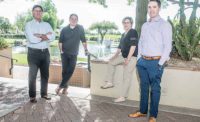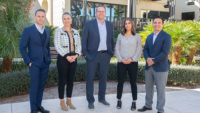ASA Roundtable: The changing world of a PHCP distributor
Part 1 of the exclusive annual ASA-Supply House Times roundtable interview highlights the current business climate, labor issues and combating online retailers.

Panelists on the 10th annual ASA-Supply House Times distributor roundtable include, from left: Paul Kennedy (Dakota Supply Group), Dan New (Mid-City Supply), Sheri Newman (Lion Plumbing Supply), John McKenzie (Winsupply) and Jeff Camuso (Charles D. Sheehy).

Charles D. Sheehy’s Camuso says the embracement of data collection is a huge industry opportunity moving forward. “It’s all about data points,” he says. “We are relying on people to make the connection, which is a little misguided. Long-term, the data is right there.”

Winsupply’s McKenzie notes the mergers and acquisition game is alive and well in the PHCP-PVF supply chain. “Private equity has so much money to spend that there Is a real willingness to throw up dollars,” he says.

Mid-City’s New says the relationship part of the equation still holds plenty of weight. “The key is finding where you have human interactions and adding incremental value,” he says. “How do you hold more value in your customers’ eyes?”




At NETWORK2019 in Washington, D.C., the American Supply Association celebrated its 50th year as the industry’s national trade association.
During that gala, another milestone was celebrated with the 10th annual installment of the ASA-Supply House Times distributor roundtable interview. Each year, a group of movers and shakers in the PHCP-PVF distribution channel gather to talk about hot-button industry topics.
This year’s esteemed panel included:
- Jeff Camuso, President, Charles D. Sheehy, Avon, Massachusetts;
- Paul Kennedy, CEO, Dakota Supply Group, Plymouth, Minnesota;
- John McKenzie, President, Winsupply Support Services Group, Dayton, Ohio;
- Dan New, Vice President of Administration, Mid-City Supply, Elkhart, Indiana; and
- Sheri Newman, Vice President, Lion Plumbing Supply, Miami, Florida.
In Part 1 of the hour-long exclusive interview with BNP Media Plumbing Group Editorial Director Mike Miazga, panelists engaged in substantive conversations about current market and business conditions, the ongoing labor saga in the industry, as well as combating online retailers, another long-running topic of conversation in the industry, but one that generated interesting responses from the quintet.
Part 2 of the interview appears in the February issue of Supply House Times.
How would you describe current market conditions in your area?
Lion Plumbing Supply’s Newman kicked things off with a candid observation. “Business has picked up lately and some of that is due to acquisitions,” she said. “One of the local suppliers was acquired by one of the nationals. Some people don’t want to deal with nationals and want to deal with smaller wholesalers. We attribute some of that to our increase.”
Camuso, whose company is an industrial PVF distributor in the Boston area, reported elevated and sustained growth. “It’s slowing down and tapering off now,” he said. “We’re not disappointed because it has elevated and stayed there. We have great bio-tech, pharma, education, health care and a lot of luxury residences being built in Boston. We’re at full employment and all the trades have been strong for years.”
Mid-City’s New noted business in the company’s Indiana and Michigan territories as being slightly up to flat, but with an anecdotal twist. “We have seen some legacy customers that haven’t been able to replace techs who have retired, so they like the level they are at and are turning business away,” he said. “We have long-time customers doing less work. Making that choice has been kind of offsetting for us.”
How is the business climate right now from a financial standpoint?
This conversation quickly turned to the continued proliferation of mergers and acquisitions in the industry. “Money is real cheap,” Dakota Supply Group’s Kennedy remarked. “It’s a good time to invest. We continue to see people invest in technology, new locations and M & A because money is cheap.”
Camuso added: “Right now is probably a good time to be acquired. The market cap of all our firms has increased quite a bit over the last few years. It’s like real estate where you buy a home for a half-million in town and now it’s worth $800,000, but now the home you want to buy isn’t $600,000, it’s a million. There are a lot of people getting a lot of money for their companies, and some are companies that don’t perform well and they are getting these unbelievable multiples. I don’t think they are doing anything innovative, they are just in the right place and they are able to capitalize on this market.”
Winsupply’s McKenzie revealed the national distributor has fielded in recent times no less than two inquiries a week related to M & A opportunities. “To Jeff’s point, the multiples often are ridiculous, that’s a good word to use because they are so out of touch with reality,” he said, “but private equity has so much money to spend that there is a real willingness to throw up dollars.”
McKenzie noted that in addition to M & A, Winsupply continues to be active on the organic growth side with new startups and expansions of existing locations, as well as making significant infrastructure investments. “We are preparing to open a new distribution center in Florida and are planning our next one, perhaps starting to look at locations in 2020,” he said. “We’re making significant investments in digital and all facets of customer satisfaction and commerce through those channels. Another is the continued investment and training of people, particularly new ones we recruit in and provide that training to.”
Newman, whose company’s showroom arm (The Kitchen & Bath Design Studio) is a member of the Luxury Products Group IMARK buying group vertical, noted select Winsupply locations have joined LPG.
What are the next big technology game-changers in the industry?
Newman didn’t miss a beat when saying artificial intelligence will be the next thing. McKenzie agreed.
“IBM put out a statistic recently where 120 million workers will be displaced by AI in the next one or two decades,” he noted. “That’s probably an error in estimation, but even if you cut that in half, that’s still 60 million people being replaced by some sort of AI.”
McKenzie then pivoted to the topic of data mining. “We are pretty passionate about capturing and utilizing all the data available to use from customers, suppliers and employees,” he said. “Data is key. Data is a valuable asset. We think harnessing data is a game-changer for all wholesalers. Would you agree with that?”
That would be an emphatic yes for Camuso. “We all have so much data,” he said, “whether that’s miles traveled, products shipped, weight carried, orders processed. And we do nothing as an industry with that data. Steve (Winsupply’s Edwards, who also was in the room during the roundtable interview) and I were on one of ASA’s ISATs (integrated strategic action team) and a woman they had come into speak told us 37% of Amazon’s revenue comes from associated products. ‘Hey, you bought this, you may want to buy this.’ We are not manufacturing as a rule. We are selling products already designed. It’s all about data points. We are relying on people to make the connection, which is a little misguided. Long-term, the data is right there.”
New chimed in: “The key is finding where you have human interactions and adding incremental value. How do you hold more value in your cus-tomers’ eyes? Is that helping them manage their stock room or managing receivables for them? We provide tech that helps them be better business-people and make more money. When we do that, we mean more to that customer in a world that is becoming more commoditized.”
“That is our view,” Kennedy added. “What are the technology upgrades we need to make to help customers? It’s about meeting the customer where they are and providing any touch point or opportunity to interact with us the way they want to interact with us. It’s a continued evolution and we are trying to catch up. I don’t know if we will be able to leapfrog incrementalism, but we have to try and stay ahead of it.”
How bad is the current labor shortage in your coverage area?
Kennedy brought up the statistic of for every five plumbers who retire, only one new one enters the industry. “We have done a lot of interactions with local trade schools and we offer scholarships to get people in the trades,” he said. “We let people know the trades are an attractive career.”
Camuso said the Boston area is doing its part to help bring new people into the trades. “The pipefitters just built a 78,000-square-foot training center in Boston,” he said. “People don’t understand the fact you can finish high school, go to trade school, make money while in trade school and come out with no student debt. You can go to school, pay no tuition, work and make money and then leave. Pipefitters and plumbers in Boston can and do make more than a $100,000 a year.”
In a lighter moment, but a startling one as well, Newman produced an applicant’s resume that was littered with spelling and grammatical errors. “This is one of the good ones,” she said. “We had a hard time finding qualified help. When we do need to hire someone, word of mouth is our best bet.
“And even if I wanted to hire this person (talking about the resume she produced), there is no contact information on it.”
Kennedy added that due to the current labor situation, the onboarding process has become even more critical. “Clearly nobody wants to hire someone with the intent of turnover,” he said. “The onboarding is now a longer period than it has ever been and there is a completely different cost associated with it, but the long-term benefits of proper onboarding are great.”
Are there any new developments with online retail threats?
While certainly a topic that has been talked about ad nauseam in recent times, panelists had plenty to say. “The differentiation for us is technical expertise and last-mile delivery,” Kennedy said. “That’s what will separate us from online threats. That’s the piece that is difficult for Amazon to replicate locally. Having that inventory close to the customer and investing in that is going to be critical.”
Camuso revealed he and some of his managers recently toured an Amazon fulfillment center in the Boston area and came away with plenty of new knowledge. “We are learning from Amazon and studying the customer experience in different ways,” he said. “There DC’s are massive, but they are just like ours with concrete floors, racks and pallets. They are doing everything we are, but they are doing it better, but not by huge margins. We share information with customers now via their mobile devices, such as the customer knowing when their delivery will arrive. We learned that from Amazon. We want to make it as easy as possible to buy from us.”
Newman asked if anybody in the group had been contacted by Amazon to sell through them. Newman revealed they were contacted but declined. “They want like a 30% cut. That’s pretty steep,” she said.
Camuso pointed out half the products in that Boston-area DC are not owned by Amazon. “It’s owned by people like us and manufacturers,” he said.
New said Mid-City has lost several customers due to online commoditization. “Fittings and PVC pipe are going away through low-cost because it’s a commodity,” he said. “Usually, it comes down to price. You have to have heart to hearts with the customer and ask them. Some customers, all they care about is that invoice price no matter how much you explain to them about rebates, promotions and value-added services.”
Next time: Distributors talk about, among other topics, what worries them most in the current business climate, as well as the benefits of being an ASA member.
Looking for a reprint of this article?
From high-res PDFs to custom plaques, order your copy today!













